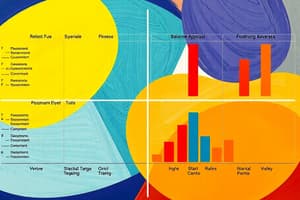Podcast
Questions and Answers
How does effective performance management contribute to achieving organizational goals?
How does effective performance management contribute to achieving organizational goals?
- By ensuring employees meet individual performance goals that collectively help the organization achieve its strategic objectives. (correct)
- By limiting employee autonomy and strictly enforcing standardized work processes.
- By creating a competitive environment among employees, fostering individual success over team collaboration.
- By focusing solely on administrative tasks such as pay raises and promotions.
In the context of performance management, what is the primary purpose of a balanced scorecard?
In the context of performance management, what is the primary purpose of a balanced scorecard?
- To provide a subjective assessment of individual employee performance.
- To prioritize financial goals over all other aspects of organizational performance.
- To serve as a tool for comparing employees' performance against each other.
- To integrate financial goals with customer satisfaction, internal processes, and organizational growth, learning, and innovation. (correct)
What role does HR play in the performance appraisal process?
What role does HR play in the performance appraisal process?
- HR primarily focuses on resolving conflicts that arise from performance appraisals.
- HR maintains records of employee performance for legal reasons and uses them when making HR decisions. (correct)
- HR conducts all performance appraisals to ensure consistency across departments.
- HR sets performance standards without input from managers or employees.
Which of the following is a key characteristic of effective performance objectives?
Which of the following is a key characteristic of effective performance objectives?
What distinguishes 'direct' methods of measuring performance from 'indirect' methods?
What distinguishes 'direct' methods of measuring performance from 'indirect' methods?
What is a primary limitation of comparative evaluation methods such as ranking?
What is a primary limitation of comparative evaluation methods such as ranking?
When using a rating scale in performance appraisals, which factor is most important to consider?
When using a rating scale in performance appraisals, which factor is most important to consider?
What is the main advantage of using Behaviorally Anchored Rating Scales (BARS) for performance appraisal?
What is the main advantage of using Behaviorally Anchored Rating Scales (BARS) for performance appraisal?
How are employees and supervisors involved in Management by Objectives (MBO)?
How are employees and supervisors involved in Management by Objectives (MBO)?
What is a key benefit of gathering performance ratings from multiple sources, such as peers, supervisors, and clients?
What is a key benefit of gathering performance ratings from multiple sources, such as peers, supervisors, and clients?
Why is rater training important in the performance appraisal process?
Why is rater training important in the performance appraisal process?
What is the primary goal of an evaluation interview?
What is the primary goal of an evaluation interview?
How often should appraisals for administrative decisions typically be conducted?
How often should appraisals for administrative decisions typically be conducted?
When should appraisals for developmental purposes be conducted?
When should appraisals for developmental purposes be conducted?
What can unacceptably high numbers of poor performance indicate regarding the HRM function?
What can unacceptably high numbers of poor performance indicate regarding the HRM function?
What is a critical legal consideration in performance appraisals?
What is a critical legal consideration in performance appraisals?
How can talent management utilize information about employee performance and potential?
How can talent management utilize information about employee performance and potential?
Which of the following is a key step in creating a performance improvement plan?
Which of the following is a key step in creating a performance improvement plan?
What can the performance management process reveal about the effectiveness of the Human Resource Management (HRM) function?
What can the performance management process reveal about the effectiveness of the Human Resource Management (HRM) function?
What should a well-prepared rater do during a performance appraisal?
What should a well-prepared rater do during a performance appraisal?
In a talent management context, what characterizes a 'Future Star' employee?
In a talent management context, what characterizes a 'Future Star' employee?
In 'Forced distribution', how are employees sorted?
In 'Forced distribution', how are employees sorted?
In measuring performance, if something is 'objective', then it most likely is what?
In measuring performance, if something is 'objective', then it most likely is what?
What is the overall purpose of 'Performance Management'?
What is the overall purpose of 'Performance Management'?
In what way can a Peer provide performance ratings?
In what way can a Peer provide performance ratings?
What is the downside to Direct Reports providing feedback on their boss's performance?
What is the downside to Direct Reports providing feedback on their boss's performance?
What does an 'Inconsistent Player' mean under the context of Talent Management?
What does an 'Inconsistent Player' mean under the context of Talent Management?
What is the disadvantage of ranking an employer's's performance?
What is the disadvantage of ranking an employer's's performance?
In a Talent Management context, what generally is a 'Solid Professional'?
In a Talent Management context, what generally is a 'Solid Professional'?
Flashcards
Performance Management
Performance Management
Managing employee performance to achieve organizational goals.
Balanced Scorecard
Balanced Scorecard
A system that integrates financial goals with customer satisfaction, internal processes, and innovation.
Uses of Performance Appraisal
Uses of Performance Appraisal
Administrative decisions, feedback, training, career planning, and test validation.
Performance Appraisal Process
Performance Appraisal Process
Signup and view all the flashcards
Effective Performance Objectives
Effective Performance Objectives
Signup and view all the flashcards
Performance Standards
Performance Standards
Signup and view all the flashcards
Direct Performance Measurement
Direct Performance Measurement
Signup and view all the flashcards
Indirect Performance Measurement
Indirect Performance Measurement
Signup and view all the flashcards
Objective Performance Measurement
Objective Performance Measurement
Signup and view all the flashcards
Subjective Performance Measurement
Subjective Performance Measurement
Signup and view all the flashcards
Ranking Method
Ranking Method
Signup and view all the flashcards
Forced Distributions
Forced Distributions
Signup and view all the flashcards
Rating Scale
Rating Scale
Signup and view all the flashcards
Behaviorally Anchored Rating Scales
Behaviorally Anchored Rating Scales
Signup and view all the flashcards
Tests & Observations
Tests & Observations
Signup and view all the flashcards
Management by Objectives
Management by Objectives
Signup and view all the flashcards
Multiple Source Appraisals
Multiple Source Appraisals
Signup and view all the flashcards
Rater Training
Rater Training
Signup and view all the flashcards
Rater Errors
Rater Errors
Signup and view all the flashcards
Evaluation Interview Approaches
Evaluation Interview Approaches
Signup and view all the flashcards
HR Records of Performance
HR Records of Performance
Signup and view all the flashcards
Performance Improvement Plan Steps
Performance Improvement Plan Steps
Signup and view all the flashcards
HRM Errors
HRM Errors
Signup and view all the flashcards
Legal Appraisal Aspects
Legal Appraisal Aspects
Signup and view all the flashcards
Talent Management
Talent Management
Signup and view all the flashcards
Study Notes
Performance Management
- Performance management is more than just performance appraisal
- Individual employee performance goals contribute to organizational goals
Approaches to Aligning Goals
- Organizational and individual performance goals can be aligned through Cascading and Linking Up approaches
Balanced Scorecard
- A balanced scorecard integrates financial goals with customer satisfaction, internal processes, organizational growth, learning, and innovation
Uses of Performance Appraisals
- Performance appraisals are used for:
- Job redesign
- Training program objectives
- Administrative decisions (e.g., pay raises, promotions)
- Criteria for test validation
- Feedback and performance improvement
- Employee development and career planning
Peformance Appraisal Process
- Setting Performance Objectives: Targets should be job-related, practical, and based on performance standards (benchmarks)
- Performance Standards: These are measurable benchmarks related to quality, quantity, and time
- Measuring Performance: Measures must be easy to use and reliable, reporting on the critical behaviors that determine performance.
- HR Records and Decisions: Performance records are maintained for legal purposes and to guide HR decisions.
- Communicate Feedback: Performance ratings and/or developmental feedback should be communicated to the employee at a specified interval
Measuring Performance
- Direct: Rater directly observes the employee's performance
- Indirect: Substitutes for direct observation, like secondhand reports or customer complaints
- Objective: Verifiable by others and usually quantitative
- Subjective: Based on the rater's opinions and not easily verifiable
Comparative Evaluation Methods
- Ranking Method: Employees are ranked from best to worst, but this is subject to halo and recency effects
- Forced Distributions: Employees are sorted into categories, with a certain proportion required in each category
Noncomparative Evaluation Methods
- Rating Scale: The oldest and most widely used subjective method, and responses may be given numerical values
- BARS (Behaviorally Anchored Rating Scales): Uses descriptions of effective/ineffective performance placed along a scale and is job-related, practical, and standardized
- Tests & Observations: May include paper-and-pencil tests or an actual demonstration of skills
- Management by Objectives: Employee and supervisor jointly establish future performance goals
Multiple Sources for Performance Ratings
- Peers: Offer unique insights when the boss is absent, and provide team-based feedback on interpersonal, leadership, and networking skills
- Customers/Clients: Provide a client perspective, including complaints and comments
- Self-Appraisals: Useful for individual improvement, though ratings are often higher than others' and provide an opportunity to highlight performance
- Supervisors/Managers: Responsible for employee performance, but may only see employees at their best
- Direct Reports: Help provide feedback on leadership/management skills of the supervisor
Rater Training
- Raters are trained on the purpose of the performance appraisal process, its alignment with the organization’s strategy, and the forms themselves
- Rater error training includes:
- Halo effect
- Error of central tendency
- Leniency and strictness biases
- Personal prejudice
- Recency effect
- Contrast errors
Communicating Feedback
- Evaluation interviews should be performance review sessions that give employees feedback
- Evaluation Interview Approaches Include:
- Tell-and-sell
- Tell-and-listen
- Problem-solving
- The interview should be a positive, performance-improving dialogue
- Frequency:
- Appraisals for administrative decisions are typically annual
- Appraisals for development should be immediately after good/bad performance or regularly (e.g. quarterly)
HR Records and Decisions
- HR uses performance records to guide their HR decisions, based on the purpose of the performance appraisal and maintains employee performance records for legal reasons
Establishing a Performance Improvement Plan
- The steps for this include getting started, developing an action plan, reviewing the performance improvement plan, meeting with the employee, following up, and PIP conclusion
Human Resource Function Feedback
- The performance management process provides insight into HRM effectiveness
- Widespread poor performance indicates the HRM function may have errors like a poor selection process or inaccurate job analysis information
Legal Aspects of Performance Appraisal
- A performance appraisal form is a legal document
- Avoid non-relevant criteria
- A reasonable time must be set for performance improvement
- Well-documented shortcomings and use of feedback interviews have been viewed favourably in court and with arbitrators
Talent Management
- Is to use information about employee performance and potential to guide employee decisions
Studying That Suits You
Use AI to generate personalized quizzes and flashcards to suit your learning preferences.




